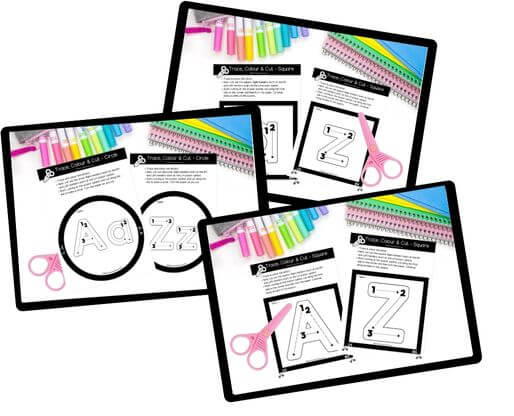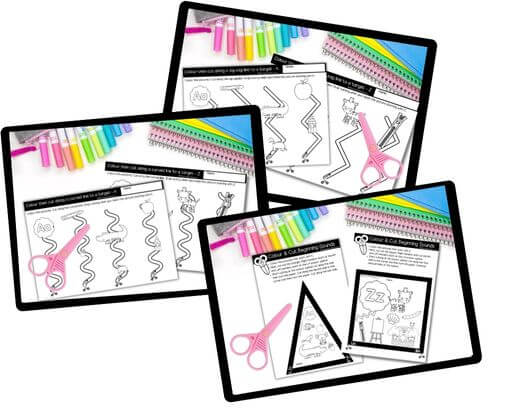Fine Motor Cutting Activities
Fine Motor Resources
Get kids excited about practising scissor skills with these fun Fine Motor Cutting Activities. Are you looking for engaging fine motor cutting activities for your students? Look no further! Cutting with scissors not only helps develop fine motor skills and coordination, but it’s also a fun and creative way for students to express themselves.
With a little patience and encouragement, you can guide your students through these hands-on cutting activities and watch as they develop their skills. Let’s dive in!
Hey there, fellow educators! As a teacher, I know the importance of fine motor skills for young students. That’s why I want to share some awesome cutting activities to help develop these skills. But before we dive in, let’s talk about what fine motor skills are, why teaching cutting skills is important, and how to teach them effectively.
What are fine motor skills?
Fine motor skills involve the use of small muscles, like those in the hands and fingers, to perform precise movements. These skills are crucial for everyday activities such as holding a pencil, using scissors, and buttoning clothes.
Why is teaching cutting skills important?
Learning to cut is an essential part of developing fine motor skills in young students. Cutting helps to strengthen the muscles in their hands and fingers, which in turn improves their ability to hold a pencil and write. Additionally, cutting helps to develop hand-eye coordination, spatial awareness, and bilateral coordination.
How to teach cutting skills
When teaching cutting skills, it’s important to start with simple activities and progress to more complex ones.
Here are some tips:
- Begin with straight lines: Encourage students to practice cutting straight lines using scissors and paper.
- Move on to curves: After students have mastered straight lines, introduce curved lines for them to cut.
- Use different materials: Offer a variety of materials for students to cut, such as construction paper, tissue paper, and foam sheets.
- Provide guidance: Offer guidance and support when students are learning to cut. Show them how to hold the scissors and use their fingers to manipulate the paper.
- Practice regularly: Encourage students to practice cutting regularly to build up their skills and confidence.
Cutting skills for left-handed students
When teaching left-handed students to use scissors, it’s crucial they have left-handed scissors.
Sounds like a no-brainer, but I know some left-handed adults who insist that it’s not important because they can cut right-handed, but if we want to give our left-handed students the best chance to develop their prewriting muscles it’s important they cut using their left hand. Having to constantly adapt is not ideal. So, make sure your lefty students have left-handed scissors for optimal cutting success!
Here are some tips for Left-Handed Students:
- Provide left-handed scissors
- Model left-handed cutting: Show left-handed students how to hold and manipulate the scissors using their left hand.
- Adjust the position – Allow left-handed students to adjust the position of their paper and scissors to find a comfortable position.
Problems students face when learning to cut
Some common problems students face when learning to cut include:
- Difficulty holding the scissors correctly
- Trouble following a straight or curved line
- Uneven or jagged cuts
- Lack of hand strength and control
If students are struggling with cutting skills, try breaking the activity down into smaller steps and offering support and guidance along the way. Or draw a smiley face on the thumb of the dominant hand and step them through the cutting process using a verbal prompt:
” Place your left/right thumb in the smaller hole and your fingers in the larger hole. Your thumb should be pointing up towards the ceiling and your fingers pointing down towards the ground. Hold the scissors close to your body and keep your elbows tucked in.”
You could even encourage students to practice without scissors with activities like:
- Squirting trigger action spray bottles – aiming for a target such as a balloon or small container.
- Using tongs – picking up small objects such as cotton wool balls, small Lego™ blocks, pieces of scrunched paper or dry pasta pieces.
- Punching holes in paper – using a single-hole paper punch to punch out a line or pattern in stiff cardboard or paper.
- Playing with clothes pegs – placing them around containers to make fences for objects or to hang out paintings, drawings, dolls clothes, socks, etc.
- Using playdough – squeezing and stretching playdough, putty or plasticine.
5 fun and engaging cutting activities for early years students
Now, onto the fun stuff! Here are some quick to set up ideas for building cutting fine motor skills:
- Cutting Practice Sheets: We have created a stack of these for you. These sheets are an excellent way to help children develop their cutting skills while also improving their hand-eye coordination. You can start with simple straight lines, then move on to more complex shapes.
- Cut out pictures from magazines: Another way to build cutting skills is to have your child cut out pictures from magazines. You can give them a theme, such as animals or food, and have them find and cut out pictures that fit that theme. This activity will help them practice their cutting skills while also improving their fine motor skills.
- Paper Snowflakes: Making paper snowflakes is a fun and creative activity that can help develop cutting skills. You can show your child how to fold a piece of paper to create different shapes, then have them cut out the design. This activity will help them practice their cutting skills while also encouraging their creativity.
- Cut fringes along a card or around a paper plate.
- Cutting Playdough: Another way to build cutting skills is to have your child cut playdough. You can give them different shapes of cookie cutters and let them cut out shapes from the play dough. This activity will help them practice their cutting skills while also improving their hand strength.
- Cutting Different Materials: You can also have your child practice cutting different materials such as fabric, felt, or foam sheets. You can draw different shapes on the material and have them cut out the design. This activity will help them practice their cutting skills while also improving their ability to cut different materials. (Supporting Research)
Check out our Cutting Printables below, we have combined cutting with other EYFS topics so you can include activities to develop cutting skills into literacy and numeracy sessions. Click the images for cutting activities that include Numbers, Letters and Sounds:
Explore tags
Cutting Activities

Cutting Activities - Shapes

Cutting Activities - Maths

Cutting Activities - Initial Sounds
Can't find what you're looking for?
Send us a request! Use this form to request a resource. Please give details of the learning area, topic, year level, curriculum links. We’ll be happy to take a look to see if we can fit it in. Unfortunately a request does not guarantee we will be able to make it!
"*" indicates required fields
